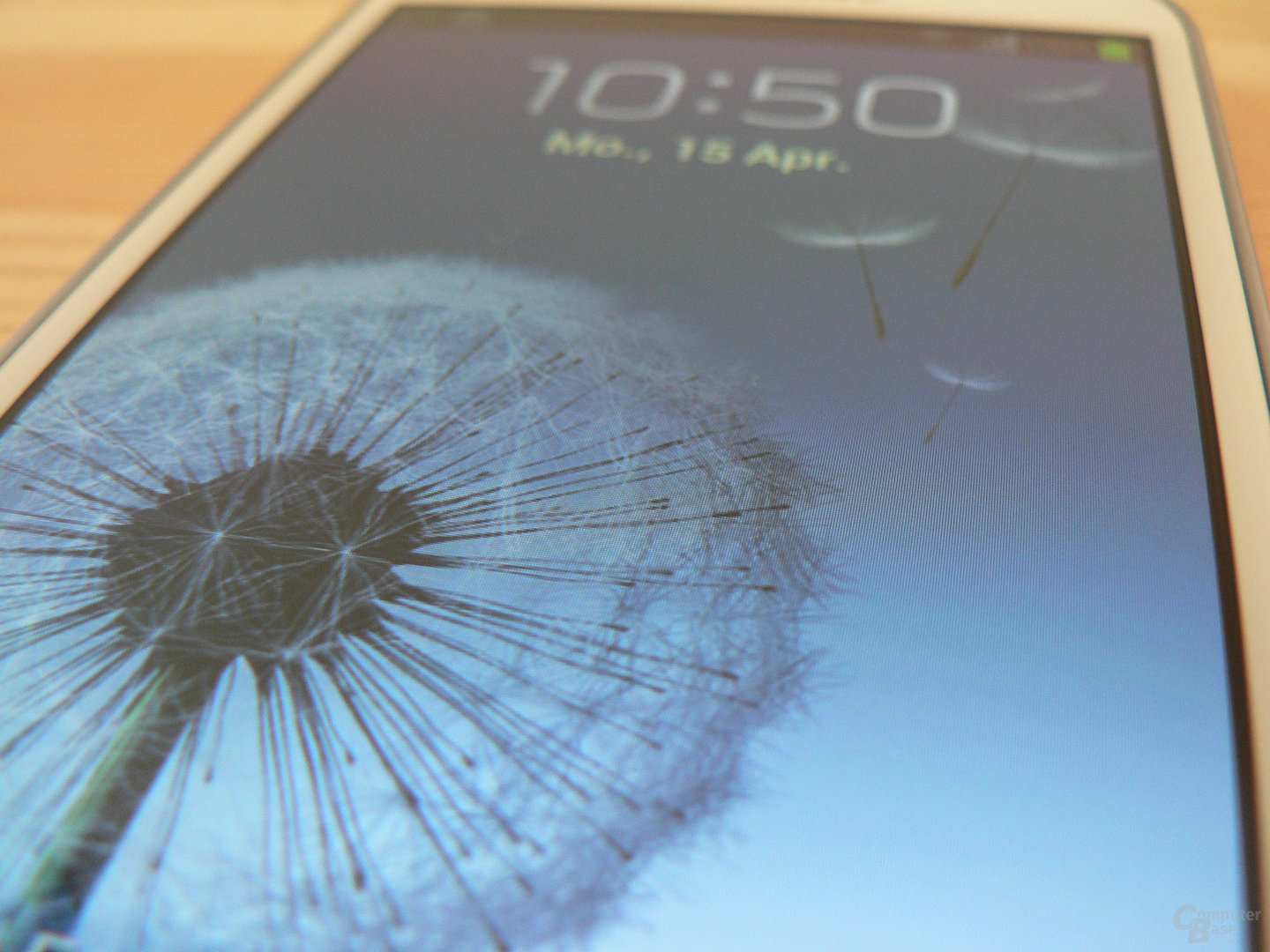Samsung Galaxy Express im Test: Ein richtiger Langweiler trotz LTE
3/6Display
Betrachtet man das Datenblatt des Galaxy Express, stellt sich schnell die Frage, weshalb die Produktentwickler ihr Gerät an mancher Stelle hinter dem gängigen Standard zurückstehen lassen. Dies gilt insbesondere für das Display, dessen Auflösung trotz einer Größe von 4,5 Zoll bei nur 800 × 480 Pixeln liegt.
An dieser Stelle macht sich am deutlichsten bemerkbar, mit was für einem Testkandidaten man es hier zu tun hat: Das Galaxy Express soll als möglichst günstiges Smartphone mit LTE-Unterstützung punkten. Dieses Ziel erscheint durchaus sinnvoll, da es in der Mittelklasse in puncto LTE noch sehr übersichtlich zugeht, doch bedeutet dies auch, dass der Preis an bestimmten Stellen „herausgeholt“ werden muss.

Vor diesem Hintergrund ist die nur noch mäßige Auflösung leichter zu verstehen, was allerdings nichts daran ändert, dass auch ungeschulte Augen sofort einen nennenswerten Unterschied zu 720p- oder gar 1.080p-Displays erkennen werden. Immerhin setzt Samsung in diesem Fall unter dem altbekannten Label „Super-AMOLED-Plus“ auf eine Non-PenTile-Matrix, sodass die Schärfe der Darstellung nicht zusätzlich unter der Display-Technologie leidet.
Sieht man von den besagten Unterschieden ab, schlägt sich der Bildschirm des Galaxy Express passabel ohne zu berauschen. Dementsprechend kann man sich über exzellente Schwarzwerte und eine gute Blickwinkelstabilität freuen und auch die Helligkeit reicht in nicht allzu hellen Umgebungen meistens locker für eine gute Lesbarkeit aus.
Als optimalen Weißpunkt sehen wir D65 an, also eine Farbtemperatur von 6.500 Kelvin (K). Dies entspricht nach gängiger Definition einem mittlerem Tageslicht und ist der Weißpunkt der gängigen Farbräume sRGB und AdobeRGB. Eine Abweichung von einigen hundert bis etwa 1000 K ist bei Mobiltelefonen als noch akzeptabel anzusehen, einige Displays – bauartbedingt vor allem OLED-Modelle – liegen allerdings beim Weiß und noch mehr bei Grautönen oft im Bereich um 10.000 K, was bereits als deutlicher Blaustich wahrnehmbar ist. Sehr viele Displays von Smartphones und Notebooks treffen zwar den Weißpunkt von 6.500 K relativ genau, weichen aber bei Grautönen und anderen mittleren Farbtönen deutlich mit einem Blaustich ab. Vor allem bei gleichzeitigem Auftreten von Grau und Weiß ist diese ungleichmäßige Graubalance wahrnehmbar.
Gegenüber der LCD-Technik weisen OLED-Bildschirme einige Besonderheiten auf, die sich teilweise in unseren Messungen niederschlagen und erklärungsbedürftig sind. Zum einen ist das der bekanntermaßen hohe Kontrast, der bei OLED durch die selbstleuchtenden Pixel möglich ist – es gibt hier kein Backlight, welches durch das Panel mehr oder weniger stark abgedunkelt wird, sondern ein schwarz angesteuerter Pixel ist tatsächlich komplett schwarz und leuchtet nicht. Da das Kontrastverhältnis den Quotienten zwischen der Helligkeit von Weiß und Schwarz angibt, ergibt die Kontrastmessung bei OLED-Displays theoretisch eine Division durch Null und damit ein nicht definiertes Ergebnis – in der Praxis gibt es bei der Schwarzmessung immer eine gewisse Resthelligkeit durch Streulicht und ein Signalrauschen beim Messgerät, sodass Kontrastergebnisse im fünfstelligen Bereich entstehen. Da die Darstellung dieser Kontrastwerte im Balkendiagramm den irreführenden Eindruck erzeugen, der Kontrast wäre bei OLED sichtbar um viele Größenordnungen besser, haben wir uns entschieden als Kontrast maximal 5000:1 darzustellen und auf diese Erklärung zu verweisen. Im Alltag ist der Unterschied allenfalls in sehr dunklen Umgebungen deutlich wahrnehmbar, bei Tageslicht sind Faktoren wie die Reflexionen der Displayoberfläche wesentlich wichtiger.
Die zweite Besonderheit ist die beim derzeitigen Stand der Technik verhältnismäßig geringe Lebensdauer der blauen Leuchtelemente bei OLED-Displays. Dies veranlasst die Hersteller dazu, zur Steigerung der Lebensdauer bei einigen Displays die klassische RGB-Subpixelmatrix durch alternative Anordnungen abzulösen. Bekannt ist dabei beispielsweise Samsungs „PenTile“-Matrix, deren Hauptmerkmal die Vergrößerung der blauen und roten Subpixel ist – allerdings bei gleichzeitiger Halbierung ihrer Anzahl. Das bedeutet, dass bei gleicher Nennauflösung diese Displays eine geringere Anzahl von Subpixeln aufweisen als Displays mit der bewährten RGB-Matrix. Jeder Pixel verfügt weiterhin über seinen eigenen grünen Subpixel, teilt sich aber den jeweiligen roten und blauen Subpixel mit seinem Nachbarpixel. Das ganze führt bei gleicher Nennauflösung zu einer geringeren tatsächlichen Auflösung und an Kontrastkanten zu Farbsäumen, die vor allem die Lesbarkeit von Text deutlich verringern können.
Führt man den Testkandidaten allerdings an einem freundlichen Frühlingstag im Freien mit, spürt man schnell, was die Testwerte bestätigen: Um die Maximalhelligkeit ist es bei rund 250 cd/m² unterdurchschnittlich bestellt, was sich schon zum Frühlingsbeginn deutlich bemerkbar macht und abermals deutlich macht, dass sich das Display insgesamt in nur durchschnittlichen Gefilden bewegt.
Als kleine Einschränkung muss dazu vermerkt werden, dass die Maximalhelligkeit wie schon beim Galaxy S III bei maximal eingezoomtem weißen Hintergrund durchaus bei Werten von bis zu 350 cd/m² liegen kann – hierbei handelt es sich aber nicht nur um eine eher praxisferne Messung, sondern auch um einen weiterhin nicht sehr berauschenden Wert.
